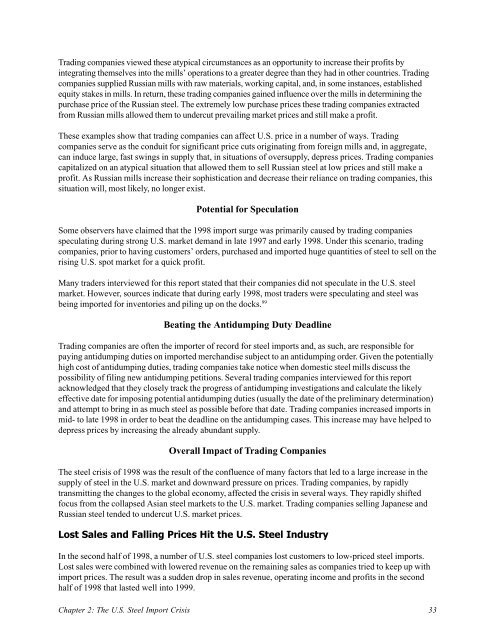Global Steel Trade; Structural Problems and Future Solutions
Global Steel Trade; Structural Problems and Future Solutions
Global Steel Trade; Structural Problems and Future Solutions
Create successful ePaper yourself
Turn your PDF publications into a flip-book with our unique Google optimized e-Paper software.
Trading companies viewed these atypical circumstances as an opportunity to increase their profits by<br />
integrating themselves into the mills’ operations to a greater degree than they had in other countries. Trading<br />
companies supplied Russian mills with raw materials, working capital, <strong>and</strong>, in some instances, established<br />
equity stakes in mills. In return, these trading companies gained influence over the mills in determining the<br />
purchase price of the Russian steel. The extremely low purchase prices these trading companies extracted<br />
from Russian mills allowed them to undercut prevailing market prices <strong>and</strong> still make a profit.<br />
These examples show that trading companies can affect U.S. price in a number of ways. Trading<br />
companies serve as the conduit for significant price cuts originating from foreign mills <strong>and</strong>, in aggregate,<br />
can induce large, fast swings in supply that, in situations of oversupply, depress prices. Trading companies<br />
capitalized on an atypical situation that allowed them to sell Russian steel at low prices <strong>and</strong> still make a<br />
profit. As Russian mills increase their sophistication <strong>and</strong> decrease their reliance on trading companies, this<br />
situation will, most likely, no longer exist.<br />
Potential for Speculation<br />
Some observers have claimed that the 1998 import surge was primarily caused by trading companies<br />
speculating during strong U.S. market dem<strong>and</strong> in late 1997 <strong>and</strong> early 1998. Under this scenario, trading<br />
companies, prior to having customers’ orders, purchased <strong>and</strong> imported huge quantities of steel to sell on the<br />
rising U.S. spot market for a quick profit.<br />
Many traders interviewed for this report stated that their companies did not speculate in the U.S. steel<br />
market. However, sources indicate that during early 1998, most traders were speculating <strong>and</strong> steel was<br />
being imported for inventories <strong>and</strong> piling up on the docks. 99<br />
Beating the Antidumping Duty Deadline<br />
Trading companies are often the importer of record for steel imports <strong>and</strong>, as such, are responsible for<br />
paying antidumping duties on imported merch<strong>and</strong>ise subject to an antidumping order. Given the potentially<br />
high cost of antidumping duties, trading companies take notice when domestic steel mills discuss the<br />
possibility of filing new antidumping petitions. Several trading companies interviewed for this report<br />
acknowledged that they closely track the progress of antidumping investigations <strong>and</strong> calculate the likely<br />
effective date for imposing potential antidumping duties (usually the date of the preliminary determination)<br />
<strong>and</strong> attempt to bring in as much steel as possible before that date. Trading companies increased imports in<br />
mid- to late 1998 in order to beat the deadline on the antidumping cases. This increase may have helped to<br />
depress prices by increasing the already abundant supply.<br />
Overall Impact of Trading Companies<br />
The steel crisis of 1998 was the result of the confluence of many factors that led to a large increase in the<br />
supply of steel in the U.S. market <strong>and</strong> downward pressure on prices. Trading companies, by rapidly<br />
transmitting the changes to the global economy, affected the crisis in several ways. They rapidly shifted<br />
focus from the collapsed Asian steel markets to the U.S. market. Trading companies selling Japanese <strong>and</strong><br />
Russian steel tended to undercut U.S. market prices.<br />
Lost Sales <strong>and</strong> Falling Prices Hit the U.S. <strong>Steel</strong> Industry<br />
In the second half of 1998, a number of U.S. steel companies lost customers to low-priced steel imports.<br />
Lost sales were combined with lowered revenue on the remaining sales as companies tried to keep up with<br />
import prices. The result was a sudden drop in sales revenue, operating income <strong>and</strong> profits in the second<br />
half of 1998 that lasted well into 1999.<br />
Chapter 2: The U.S. <strong>Steel</strong> Import Crisis 33
















